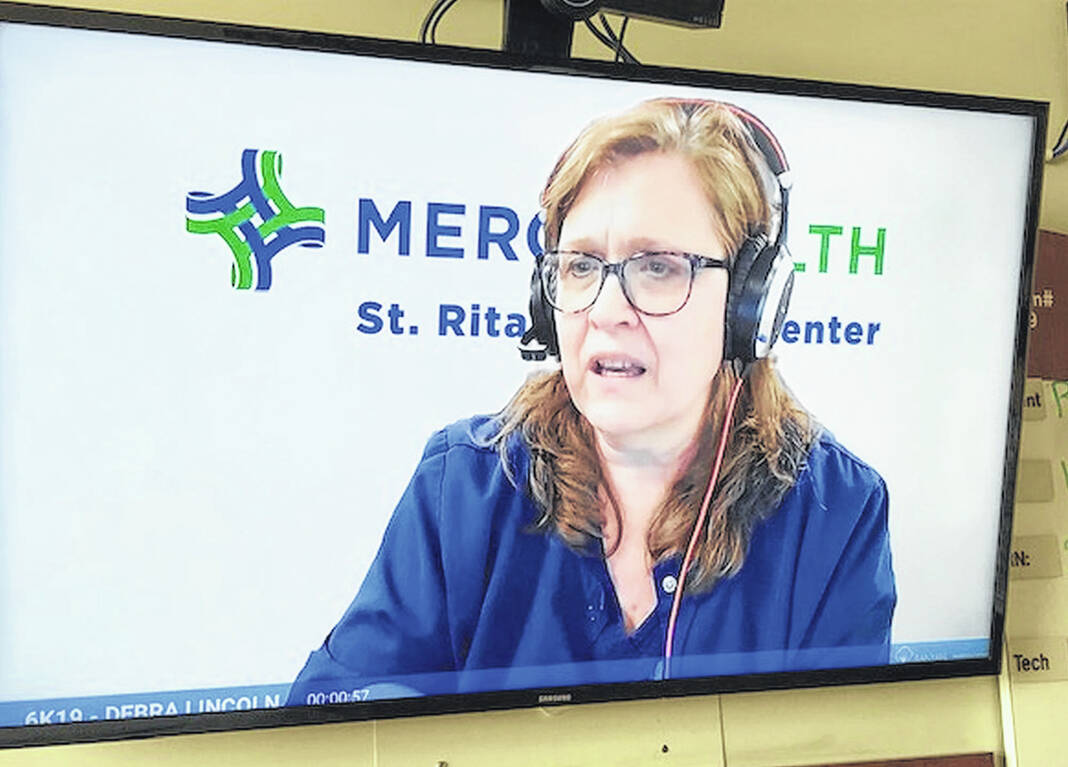St. Rita’s testing virtual nursing technology
LIMA — A new virtual care system was unveiled in June at Mercy Health-St. Rita’s Medical Center. The Banyan Virtual Nursing System was so successful on the unit where it was initially implemented that it was added to two additional units last week.
Currently, St. Rita’s is the only facility in the Mercy Health system to utilize the technology, and proponents hope that it will help nurses better provide patient care.
“Nurses want a collaborative team and want to work at the top of their [licensed] practice,” St. Rita’s Director of Nursing Brooke Taviano said.
With that in mind, the administrative and management teams traveled to Michigan to meet with other healthcare providers who had implemented the system. While the initial meeting took place approximately three years ago, “COVID accelerated the interest,” Taviano said.
What is virtual nursing?
Virtual nursing involves the use of technology that enables a nurse to view a patient from a remote location.
“Patients have been more on board with virtual [healthcare] since the onset of COVID,” St. Rita’s Director of Central Staffing and Scheduling Eva Hill said.
Hill indicated that patients have the “option of opting out” if they are uncomfortable with the concept.
The Banyan system consists of a television-mounted Banyan Bridge camera, a Rainbow Light that appears when the camera is activated, built-in audio and a microphone, using the same call system already in use at the patient’s bedside.
While there is no video recording that occurs with the system, the virtual nurses are able to access the patient‘s electronic medical record (EMR) and provide clinical documentation via St. Rita’s records system.
“[Virtual nursing] frees up the primary nurse by alleviating some of the documentation, improves patient safety and improves patient education,” Hill said.
Registered Nurse Kirstie Griffo appreciates that St. Rita’s has invested in the system.
“I love that it gives more time for the nurse to spend quality time with patients,” she said.
Virtual nursing in action
Registered Nurse Debra Lincoln serves in the virtual nursing role. The virtual nurses typically perform “safety rounds” every four hours. She reports that her camera permits her to see the oxygen level the patient is receiving and to view the patient’s IV site. She is able to report back any concerns to the patient’s on-site nurse.
While the hands-on portion of the admission assessment is performed by the bedside nurse at St. Rita’s, the virtual nurse is able to collect data during the admission, such as health history and medication list. Virtual nurses also assist with discharge planning, reviewing discharge medications, follow-up plans and any specific instructions the patient needs prior to discharge.
“We can make sure [patients] understand their diagnoses,” Lincoln said.
The virtual nurse can provide a double check of high-risk medications. The virtual nurse and bedside nurse perform the five rights of medication administration: the right patient, the right drug, the right dose, the right route and the right time. The virtual nurse then enters his or her credentials into the EMR.
Taviano appreciates the “collaborative effort” between primary and virtual nurses. She also notes that virtual nursing provides a “keen ability to build a nursing care plan.”
Hill finds virtual nursing especially helpful during emergency situations such as a “rapid response” or “code” scenario. Virtual nurses can assist with documentation during those situations and can provide additional clinical information from the EMR. Bedside nurses at St. Rita’s have the ability to contact a virtual nurse via the EMR system, making access more efficient.
Patient consent
Prior to the virtual nurse “entering” the patient’s room, a ring tone alerts the patient that the nurse plans to initiate communication. Once the patient is alerted, the virtual nurse obtains the patient’s verbal consent to begin the video encounter. Patients have the option of consenting or declining the video each time the virtual nurse makes the request.
Currently, only the nursing aspect of the Banyan Virtual Care System is utilized at St. Rita’s, but in the future other disciplines, such as pharmacy and physical therapy, may collaborate with nursing in its use.
Effectiveness of virtual nursing
Virtual Nursing is being evaluated for its benefit to patients and nursing staff through the use of Key Performance Indicators (KPIs). KPIs are measurements used to evaluate the success of a particular activity.
“KPIs for virtual nursing include patient safety, medication reconciliation, re-admission rates and nurse/patient communication,” Taviano said.
The virtual care system is expected to improve quality and the patient experience. It is anticipated that patient call light usage will decrease by 50 percent due to more care team interactions.
Taviano, Hill and Griffo all agree that the Virtual Nursing system enables the on-site nurses to have more quality time with their patients. They also believe the system may indirectly assist with the recruitment of nurses, since there will be “seasoned nurses” available virtually to assist with concerns that a novice nurse may have about a patient.
Registered Nurse Debra Lincoln checks in on a patient using a new virtual nursing system currently being evaluated at Mercy Health-St. Rita’s Medical Center.








Gloss